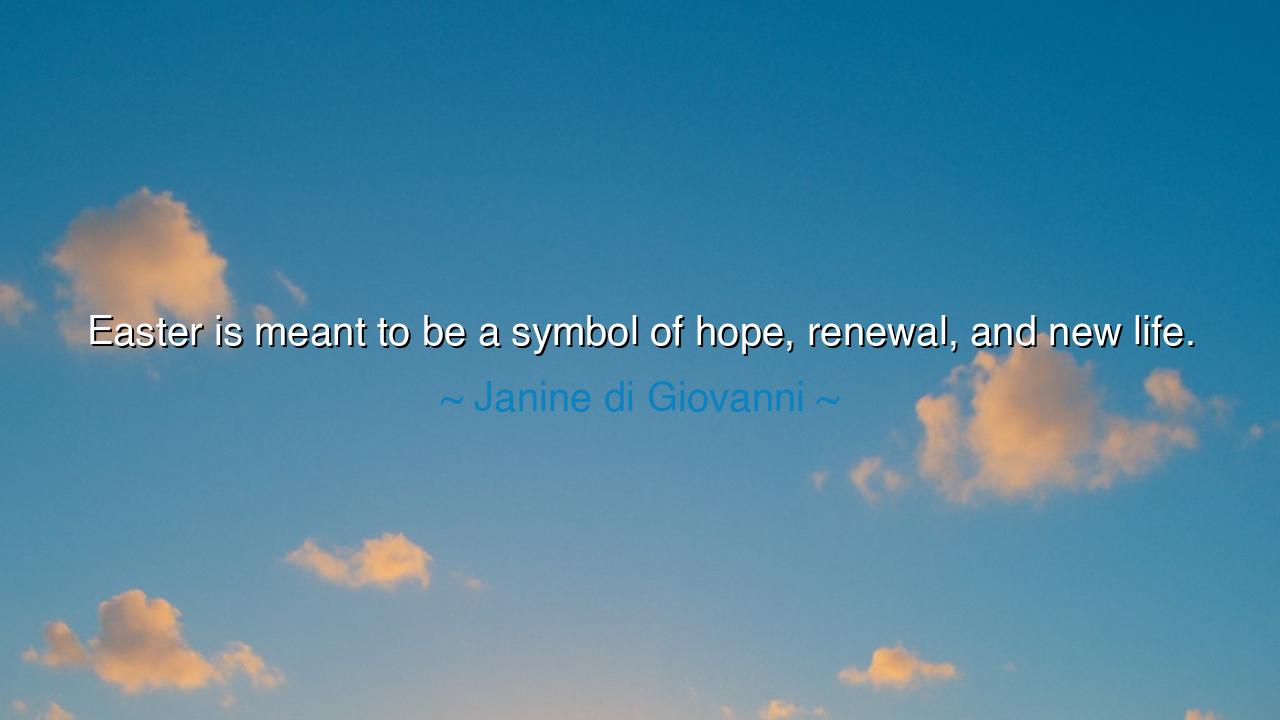
Easter is meant to be a symbol of hope, renewal, and new life.






“Easter is meant to be a symbol of hope, renewal, and new life.” Thus spoke Janine di Giovanni, a journalist and witness to the deepest sorrows of humankind — war, loss, and the resilience that rises from both. Her words are not those of a theologian, but of a soul that has seen darkness and yet still believes in the return of light. In this simple truth, she captures the eternal rhythm of existence — that from death comes rebirth, from despair arises hope, and that life, no matter how fragile, finds a way to renew itself. Easter, in her vision, is not merely a feast of faith, but a reminder to all humanity of this sacred and universal law.
From its origin, Easter has been the festival of resurrection — the celebration of Christ rising from the tomb, triumphant over death. To the early Christians, it was not simply the remembrance of one man’s return, but the awakening of a new possibility: that life is not bound by the grave, and that the spirit cannot be destroyed. Yet even before Christianity, ancient peoples celebrated this same mystery through their spring rituals — the renewal of the earth after the long sleep of winter, the return of the sun, the bursting forth of green from soil once barren. In every age and every culture, humankind has looked to the turning of the seasons to find proof that life renews itself, even when all seems lost.
But Janine di Giovanni, having walked through the ruins of war-torn lands, saw that the spirit of Easter reaches beyond religion and into the very essence of survival. She has seen cities crumble and nations fall, and yet, amid the rubble, she found mothers rebuilding, children laughing, people planting gardens where graves once lay. In such moments, the true meaning of Easter reveals itself — not as ceremony, but as courage. It is the will to believe in life after devastation, to stand up and say, “The darkness is not the end.” For even in the ashes of ruin, hope stirs like a heartbeat waiting to be heard.
This truth was known to the ancients as well. The Egyptians told of Osiris, who was torn apart and scattered, yet brought back to life by love and faith. The Greeks spoke of Persephone, descending into the underworld and returning each spring to bring life back to the fields. In these myths, as in Easter, the message is the same: death is not destruction, but transformation. The wise understood that life moves in cycles — of loss and renewal, grief and rebirth — and that to despair is to forget the promise written into the fabric of nature itself. For just as the seed must die to become the tree, so must the soul endure its winters to find its spring.
Consider the story of Viktor Frankl, a man who endured the horrors of the concentration camps during the Second World War. Surrounded by death, he still found meaning in life, writing later that “everything can be taken from a man but one thing: the last of human freedoms — to choose one’s attitude.” In the heart of hell, he saw that even in suffering, there is the potential for renewal — that hope can be born not despite despair, but within it. Frankl’s survival, like the message of Easter, stands as a living symbol of resurrection in spirit — proof that the light of the human soul cannot be extinguished by any darkness.
To understand renewal as Easter teaches it is to understand that life demands both the dying and the rising — not only of bodies, but of dreams, relationships, and selves. Every ending carries within it the seed of a beginning. Every failure, if met with courage, can become transformation. The lesson of Easter, then, is not confined to one holy day; it is a way of being. It is the art of believing, even when belief feels impossible. It is the strength to forgive when hatred tempts the heart. It is the humility to begin again, to build anew, to plant where something has been lost.
So, my child, take this teaching deeply into your heart. Easter is not only a date, but a state of being. It is the moment you choose hope over despair, the day you decide to rise after falling. Let every morning be your resurrection. When grief burdens you, remember that even the coldest winter yields to spring. When you feel broken, recall that from broken ground come flowers. The power of life — of new life — is already within you, waiting only for your faith to awaken it.
For as Janine di Giovanni reminds us, Easter is the symbol of hope, renewal, and new life — and this symbol is written not only in scripture, but in the pulse of the earth and the breath of every living soul. Wherever you stand — in sorrow or in joy, in darkness or in dawn — remember this truth: life forever renews itself, and you, too, are part of that endless resurrection.






AAdministratorAdministrator
Welcome, honored guests. Please leave a comment, we will respond soon